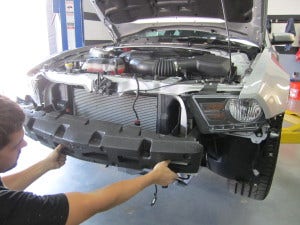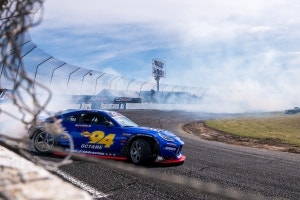
2011-2014 Ford Mustang GT Direct-Fit Oil Cooler Kit, Part 2: Initial Prototype Design and Testing
Interested in purchasing our Mustang oil cooler? Check out our product page for more information!
Mishimoto Ford Mustang 5.0L Oil Cooler Kit
With our test vehicle in the shop, our team set to work planning our attack on this Mustang. Our primary goal was to achieve significant temperature decreases. We got this beast in the air and inspected our challenges with the oil sandwich plate location. Our standard and thermostatic sandwich plates use either a ¾-16 or M20 sandwich plate adapter. This component secures the sandwich plate between the block and the oil filter.

Oil sandwich plate exploded

Oil sandwich plate assembled
The images above show the orientation of the sandwich plate and filter on the engine. Oil passes through the filter, then into the sandwich plate. The two ports on the plate will have lines feeding the cooler. Once through the cooler the oil will return to the sandwich plate via the second port and back into the engine. This is a common practice for adding an oil cooler to a vehicle that is not equipped with one from the factory.
As described above our current offerings are for ¾-16 and M20 threads, but the Mustang features an M22 filter thread. This means we would need a new sandwich plate! It is not all bad news on the sandwich plate front. This vehicle has a fair amount of space in the engine bay, so we could utilize one of our thermostatic sandwich plates, and line routing would be fairly simple. Check out what we are dealing with!

Oil filter location

Oil filter location

Oil filter location
Once we were satisfied with the plan to create a new sandwich plate, we compared the pros and cons of the thermostatic vs. non thermostatic plates. A thermostatic sandwich plate works similarly to the coolant thermostat in your vehicle. Once a specific temperature is reached, the thermostat opens and allows oil to flow through the cooler. So why would someone want this? Obviously everyone is aware that hot oil temperatures can damage your engine. Oil degradation is a serious problem. That being said, cold oil temperatures are also a potential hazard to your Coyote. This is why many choose to allow the vehicle to warm up properly before laying the pedal to the floor. Mishimoto currently offers an optional thermostatic sandwich plate with a majority of our direct fit oil cooler kits. This option is especially recommended for those using their vehicle as a daily driver or for those living in cooler climates.
After a heated debate, our team decided that this kit must include a thermostatic plate. Our goal is to protect your engine. Including the thermostatic plate would allow full regulation of oil temperatures. Next, it was time to select a location for the cooler.
The front bumper or grille area was targeted because of the fresh, cool airflow.

Bumper removal

Bumper removed

Bumper removed
So this is what we are left with, shown above. The huge amount of open space provides room for our team to get creative with the design of this kit. The design would be very different than the ones for smaller vehicles, where every inch matters.
For our first design, the plan was to mount the cooler in the upper portion of the grille. This location looked like a great spot for airflow, and we a few available mounting points that would work very well.
Steve, the lead engineer for this project, began fabricating the brackets.

Bracket design 1

Brackets on cooler
These two brackets would suspend the cooler from mounting points on the radiator support. Two additional brackets would support the base of the cooler to points on the bumper support. We would be using strong material that would have no problem supporting the cooler.
These brackets were then fitted to our Mishimoto 25-row stacked plate oil cooler and installed in the vehicle. This is currently our largest oil cooler option and would provide greater heat transfer than our 10-row and 19-row coolers. The larger size also provides increased surface area for airflow and increased capacity. Both these benefits will result in lower fluid temperatures. Check out the mounted upper brackets!

Version 1 upper brackets mounted

Version 1 upper brackets mounted
The images above show the location of the brackets and the cooler in relation to the upper radiator support. We need to keep in mind the routing of our oil lines when placing the cooler.

Version 1 upper brackets mounted
Once the upper brackets were installed and solidified, we needed to link the base of the cooler to the bumper support. Without lower supports, our team was concerned about the cooler making contact with the A/C condenser.

Version 1 passenger side lower bracket mounted

Version 1 lower brackets installed
Once the four brackets were installed, the cooler was adequately supported and cleared all factory components in this space. The clearance to the condenser would provide some room for flex. Check out some close-up shots below.

Version 1 brackets and cooler installed showing clearance to condenser

Version 1 brackets and cooler installed from below
So with this design in place we needed to slap some testing equipment on and get this pony on the street for some data collection. We use PLX devices for capturing live information, and we also have the ability to record and log our sensors. For this particular test we will be collecting oil temperature and pressure.

PLX sensors installed

PLX sensors installed
The multi-colored sleeves house the sensor harnesses that run into the cabin of the vehicle. These wires are connected to our PLX devices box which then displays information on our laptop.

Mishimoto PLX box

Gathering live data
Once all our testing equipment was set, we hit the road to collect some information. Our team drove on the highway for several miles at 65 mph. Special attention was given to vehicles in front of the Mustang to ensure that proper airflow was reaching the front of the car. After completing the test drive, we returned to the shop, removed the Mishimoto oil cooler kit, and installed all the stock components. We then collected baseline temperature information to use as a comparison with our design. We repeated the driving conditions performed in the first test drive to ensure that the comparison was as accurate as possible. All testing was completed in 85-to-90 degree weather during the late summer here in Delaware.
Analysis of the data revealed that the average temperature drops around 20°F, which was a nice decrease from the factory setup without any cooler. We were also surprised to see that oil temperatures were around 220 degrees without any cooler installed. With just normal highway driving, 220°F is rather high; a day on the track or stressful driving might increase that significantly. Any temperature over 240 to 250 degrees is working its way into the danger zone of reduced oil viscosity. At this point your oil thins and becomes less efficient at lubrication. This is not a problem you want to have.
With testing complete our engineers evaluated our design and looked for ways to improve efficiency. Twenty-degree temperature drops are great, but we felt that we could improve efficiency even further. Our next task was to assess airflow. Our current core position was in the upper grille area, and we were curious to see if there were differences in airflow between this location and the lower bumper opening. We tested airflow using our anemometer and found that we could improve flow by moving the cooler to the bumper location.

Anemometer
The anemometer is essentially a small windmill-like device that accurately measures wind speed. With this information, we needed to revise or reconstruct our bracketing system to move the cooler to the new location.
Check back for the next update with our new cooler mounting setup and testing!




